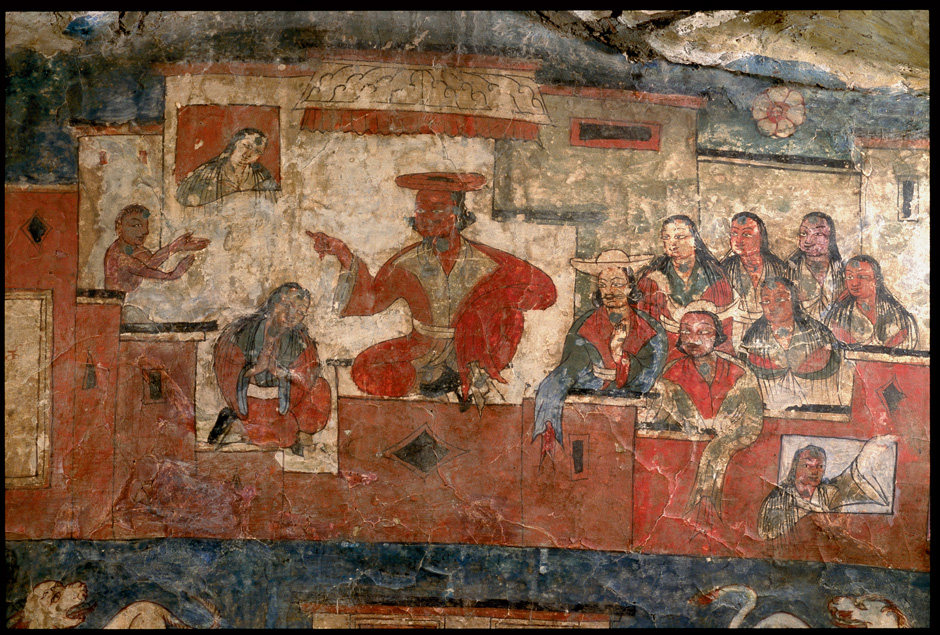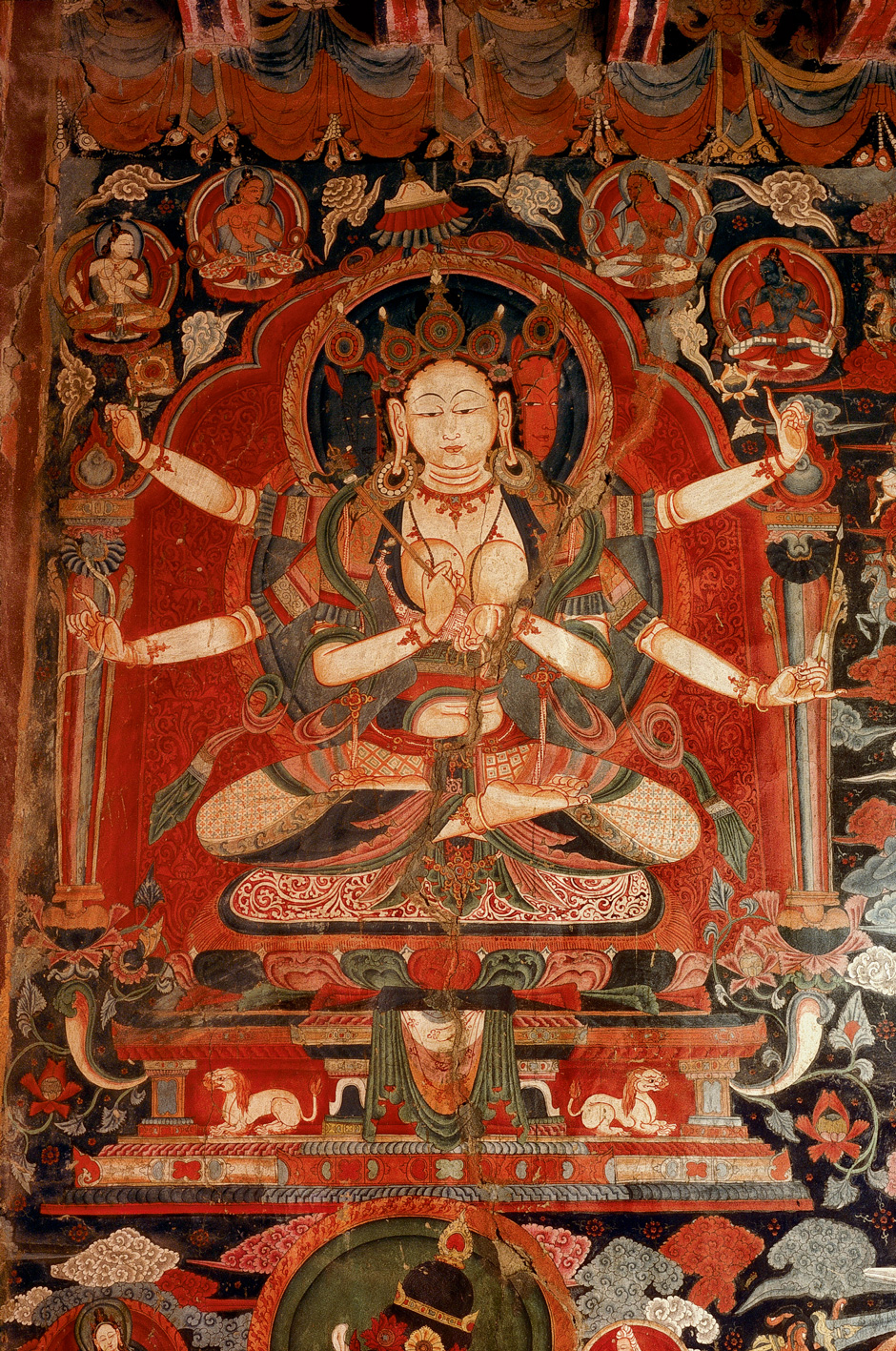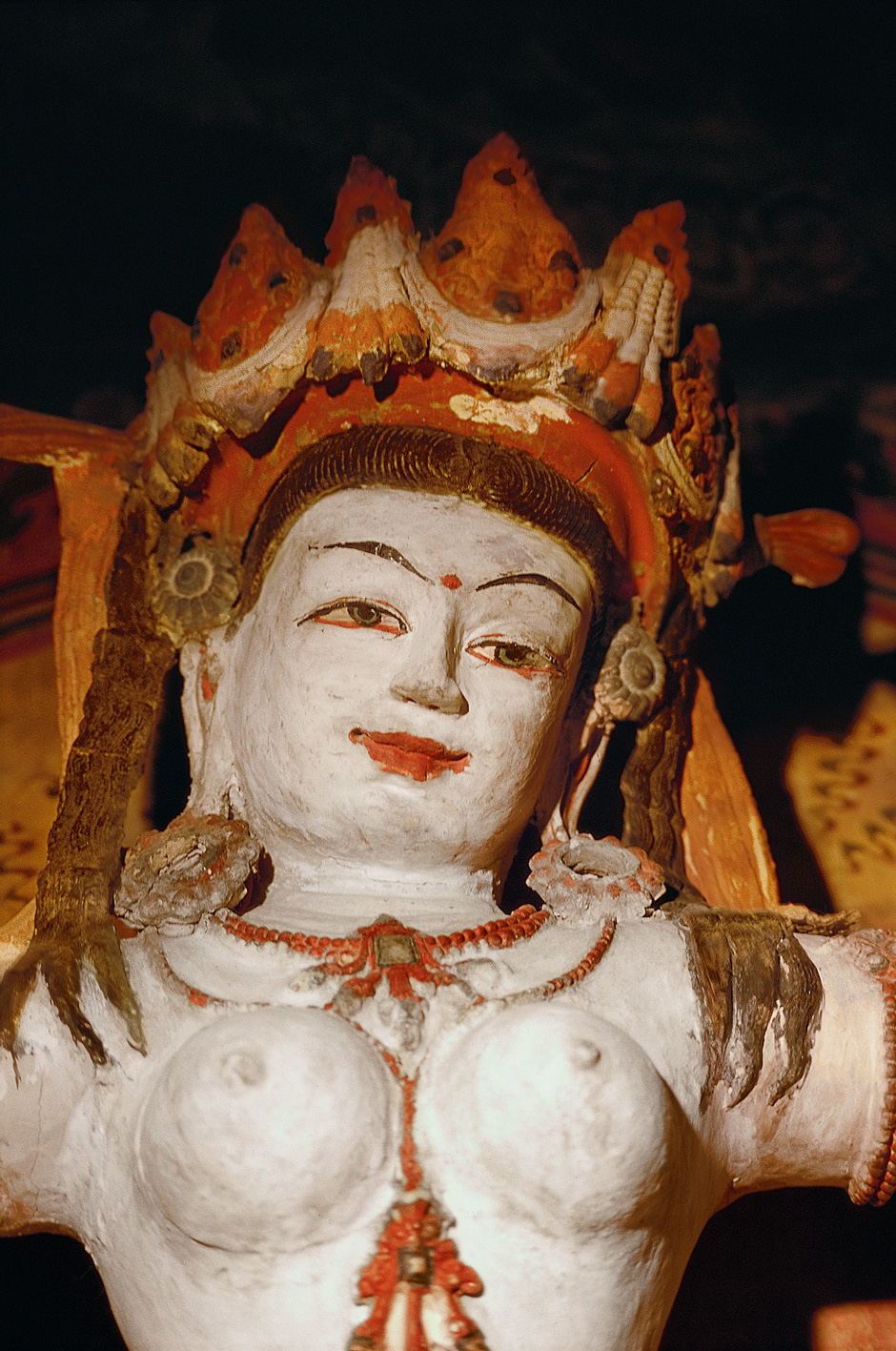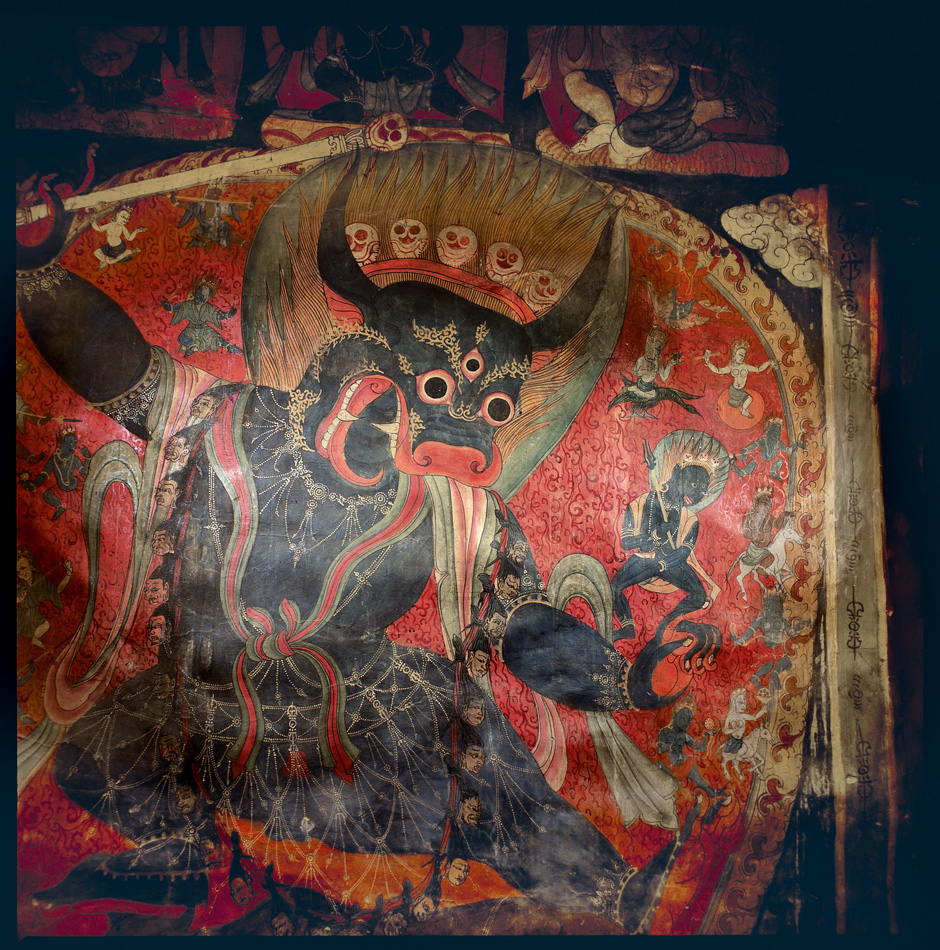There was a young man named “Super-Wealthy,” Sudhana in Sanskrit, probably from the Andhra region in southern India, who hungered for truth, or understanding, more than anyone before or after him. He spent years moving from one teacher to another—fifty-three in all, including various Buddhas-to-be, maverick ascetics, learned scholars, merchants, a fishermen, a mariner, ordinary householders, kings, a beggar, a goldsmith, a perfumer, a Hindu god, several women (one of them a young girl), and the eight Goddesses of the Night. Each had something unique to teach him about the ways of the world and the mind; each became for Sudhana a kalyana-mitra, a loving friend. But the true climax of this long progression came when Sudhana was invited to enter the tall palace or tower of Maitreya, the longed-for Buddha of the future:
He saw the tower immensely vast and wide, hundreds of thousands of leagues wide, as measureless as the sky, as vast as all of space, adorned with countless attributes; countless canopies, banners, pennants, jewels, garlands of pearls and gems, moons and half-moons, censers giving off fragrant fumes, showers of gold dust….Also, inside the great tower he saw hundreds of thousands of other towers similarly arrayed; he saw those towers as infinitely vast as space, evenly arrayed in all directions, yet these towers were not mixed up with one another, being each mutually distinct, while appearing reflected in each and every object of all the other towers.
These innumerable mutually reflected towers were inhabited by endless families of Buddhas and Bodhisattvas, Buddhas-to-be. But there was one tower higher than all the others, in which Sudhana saw a billion universes unfolding one by one, each embedded in and reflected by all the others; and in each of them Sudhana saw himself, bowing at Maitreya’s feet.
Sudhana’s path to understanding is recorded in one of the most ravishing of all Buddhist texts, the Sanskrit Gaṇḍa-vyūha (itself the final part of the immensely popular Avataṃsaka or Flower-Ornament Sūtra). We’re not sure what the title means: vyūha is something like an arrangement, an array, probably in the sense of a visual map of the universe; gaṇḍa means, among other things, a rhinoceros, a mark or spot, a stalk, or a bubble. So, perhaps, the Gaṇḍa-vyūha offers us, as Sudhana’s teachers offered him, “the cosmos seen as a bubble”: evanescent, radiant, light as empty space, yet overflowing with ever more beings and things.
There are only two sites in the world where we find a complete set of illustrations for Sudhana’s story—one, in finely carved stone reliefs, at the great Buddhist monument of Borobodur in central Java (circa 800 AD), and the second in a remarkable sequence of painted murals in the Du-khang or Assembly Hall within the main shrine in the remote monastery of Tabo, situated in the arid, wind-swept Spiti Valley in northern India very close to today’s border with China (more specifically, to the historic kingdom of Guge in western Tibet). The Tabo paintings were completed in the mid-eleventh century, perhaps in conjunction with the arrival in the western Himalaya of the great Indian teacher Atisha, a central figure in what is usually called the “second wave” of Buddhist teaching in Tibet. Tabo, the most intact of all early medieval Buddhist artistic sites in the Western Himalaya, has been well studied—first by the great Tibetologist-explorer Giuseppe Tucci in the 1930s, and in our times by Deborah Klimburg-Salter, Christian Luczanits, Luciano Petech, Laxman S. Thakur, and Ernst Steinkellner. Peter van Ham, an authority on early Indo-Tibetan art, has now given us a splendid photographic record of the Tabo masterpieces—undoubtedly the finest pictures we have from this site, along with the superb images taken by Christian Luczanits that are available on the Internet. (To my taste, however, there is something about the color photographs in Deborah Klinburg-Salter’s Tabo: A Lamp for the Kingdom that truly captures the strange and moving texture of the original paintings.)
The painted panels in Tabo vary greatly in the elegance of their designs and in their execution; some of the figures are almost primitive, others—particularly the Bodhisattva panels—of a breathtaking complexity and finesse. All of them, however, seem to reveal to our eyes not merely the concrete phenomena (persons, deities, trees, animals) that we can identify by name but something of that empty spaciousness that has generated them. Especially powerful in this respect is the palette of colors the artists have used: the strangely muted yet radiant reds and ochres, the blues or pale black that often serve as background, filling the interstices of the panels and shading off into a shimmering golden green when yellow is mixed in. There is also a lively, granular, sometimes eerie white or beige infiltrating the inner surfaces of the figures and the burgeoning landscapes through which they move. It is also important to see the major panels, such as what is left of the large-scale depiction of Sudhana’s entry into Maitreya’s tower, as artistic wholes, teeming with the living creatures that inhabit these visionary inscapes.
Advertisement
Together with the photographs, many of them taken under extremely trying conditions, most of them astonishing in their clarity and imaginative spatial framing, we are given a series of essays about the iconographic program of the Tabo shrine. Sudhana is by no means the only artistic subject here; there is an exquisite series of paintings on the life of the historical Buddha Shakyamuni as well as a rich menu of other images, including a major set of thirty-three life-size painted clay sculptures of Buddhas and Bodhisattvas, some of them looking serene, others rather spooky. Of primary importance is the arrangement of these colorful clay figures in what is called the “Circle of Crystalline Truth,” vajra-dhātu-maṇḍala. At the center of this three-dimensional circle we see a four-bodied image of the Buddha of Light, Mahavairocana, embodying the luminous adamantine force of liberating insight—the heart of the Mahayana Buddhist program. The other thirty-two clay figures, towering over the painted narrative panels, are arranged in symmetrical rows mirroring one another. The plan of the circle as a whole, possibly revealed in a dream to the lamas who initiated it, is clearly meant to move the pilgrim to Tabo through a sequence of interlocking internal states and processes culminating, if all goes well, in his or her merging, possibly irrevocably, with the central Buddha of Light and with the awareness that is proper to him.
Moving through this crowded space, the pilgrim enters into the underlying “emptiness”—really a kind of infinite spaciousness—that is the stuff of Tibetan Buddhist reality. It may be strange to think that a universe so densely populated is actually, in some profound sense, empty. Judging by the literary sources we have available, to take this spaciousness into oneself, momentarily clearing heart and mind of the detritus that normally clogs our perceptions, provides a sense of vast psychic relief. The seemingly empty space is, however, a highly active arena within which our minds weave the web that we take to be the world—a world filled with objects such as Maitreya’s towers and manifold creatures and, of course, these same Buddhas and Bodhisattvas continuously emerging out of empty space and dissolving back into it. A pilgrim proceeding through the Circle learns first to see them doing this, then to make them do it purposefully, and finally to control the same processes in his or her own restless existence, in his or her mind.
We can formulate in relatively straightforward language something of what this playing with consciousness might mean, despite its evidently abstruse and esoteric character. (I once heard His Holiness the Dalai Lama say, “We Buddhists think that truth is ineffable—but not very ineffable.”) It is best to avoid altogether the distorting language of symbolism and representations when speaking about the Circle and its overpowering figures, though van Ham, like many art historians, does gravitate to such terms. The Buddhas and Buddhas-to-be sitting in state on the walls of the Assembly Hall, like the painted deities that surround them, are at least as tangible and real as anyone looking at van Ham’s photographs. They have nothing in common with symbols.
Tibetan Buddhism is a religion of astonishing hopefulness, for it teaches us that the mind we are born with is the perfect instrument with which to see truth or, better, to become truth, although we habitually demean this instrument and use it (the mind is not an “it”) to enslave ourselves further. Hope also lies in the presence of a precise map, or path, to take us, unerringly, to the goal we seek. As we can see from the culmination of the Sudhana story, this practice involves a strong reflexive element: along with the visualization of the various divine beings inside the Circle, inside the mind, one has to visualize one’s own existentially tenuous “self” replicating itself infinitely as visible projections within the mirror-like realms of the inner eye.
As I lingered over van Ham’s photographs, I began to wonder if the Crystal Circle could work its magic even on a person sitting at home, far from Tabo, and turning the pages of this fine book. Somehow it feels like it could; but this thought may be yet another trick of the mind.
Advertisement
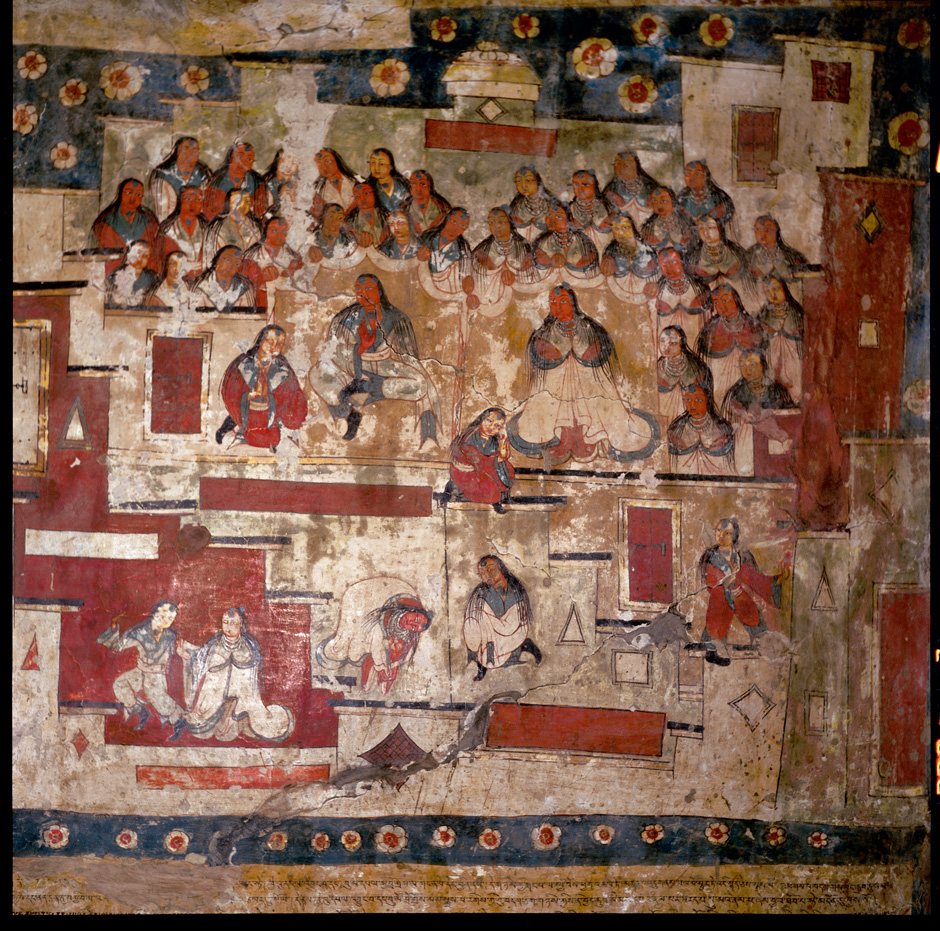
Peter van Ham
A painting of Sudhana with the boy Shrisambhava and the girl Shrimati, among the last of the series of the kalyana-mitra, or loving friends, Sudhana visits on his journey in search of learning and enlightenment; the children share with him the realization that everything of this world is produced by the illusion of causes and conditions
Peter van Ham’s Tabo—Gods of Light: The Indo-Tibetan Masterpiece is published by Hirmerverlag.



